Argomenti trattati
The origins of the AMA Superbike Championship
The AMA Superbike Championship, a prestigious motorcycle racing series in the United States, has a rich lineage that dates back to 1973. Originally birthed from the AMA Open Production event, this racing series has transformed into the pinnacle of motorcycle road racing in the country. Organized by MotoAmerica and sanctioned by the American Motorcyclist Association (AMA) and the Fédération Internationale de Motocyclisme (FIM), it features highly modified, production-based liter-class motorcycles competing at some of the finest racing tracks across America.
The inaugural event took place in 1973 at the famed Laguna Seca Raceway, where the AMA Open Production class showcased its first races. As the series evolved through the years, it gained significant traction among racers and fans alike, eventually leading to the establishment of the AMA Superbike Championship in 1986. This transition marked a pivotal moment, as road racing was separated from dirt-track events, allowing the Superbike category to flourish independently.
The rise of production-based racing
In the early 1970s, AMA road racing was characterized by two distinct classes: Heavyweight and Lightweight. These classifications were built around factory-backed teams that often had access to extensive resources, creating a competitive edge. However, as motorcycles like the BMW R90S, Kawasaki Z1, and Ducati 750SS emerged, the landscape of racing began to shift. These high-performance machines became accessible to amateur racers, paving the way for grassroots racing events across the nation.
The invitations extended by AMA race promoters to production racers for the Laguna Seca AMA National Road Race Weekend in 1973 ignited a passion for production-based racing. The Open Production class quickly gained popularity, leading to more events dedicated to this racing format. As motorcycles continued to evolve, so did the regulations, resulting in the establishment of Superbike Production as a formal championship class by 1976.
The competitive landscape and technological advancements
The early years of the AMA Superbike Championship were dominated by European manufacturers, with BMW and Ducati leading the charge. The introduction of the Japanese inline-four motorcycles from Kawasaki, Suzuki, and Honda shifted the balance of power in the late 1970s. These bikes, while powerful, struggled with handling due to strict regulations that limited chassis modifications. As teams adapted their strategies and made engine modifications, the competitive landscape became increasingly dynamic.
By the mid-1980s, Honda’s entry into the series with their VF750F marked a significant turning point. This motorcycle was designed specifically for racing, featuring advanced technology that eclipsed earlier models. Honda’s success with the VF750F and its successors solidified its dominance in the AMA Superbike Championship, winning multiple championships in consecutive years. However, competitors like Suzuki and Ducati were not far behind, continually innovating to keep the competition fierce.
The impact of homologation specials
The growth of production-based superbike racing saw the emergence of homologation specials, motorcycles specifically designed for racing and produced in limited quantities. These machines, such as the Ducati 851 and Honda RC30, exemplified the intersection of street legality and racing prowess, capturing the attention of both manufacturers and fans. The creation of these high-performance motorcycles not only fueled competition but also drove technological advancements that would shape the future of motorcycle engineering.
Shifts in ownership and the future of AMA Superbike
As the AMA Superbike Championship continued to evolve through the late 2000s and early 2010s, significant changes in ownership and management occurred. In 2008, the AMA sought to distance itself from the racing side of operations, leading to the sale of sanctioning rights to the Daytona Motorsports Group. This decision aimed to revitalize the series, but it also resulted in a decline in manufacturer participation and overall race entries.
Fortunately, in 2014, MotoAmerica emerged as a new promoter for the AMA road racing series, reigniting interest and participation in the championship. Under this new management, the AMA Superbike Championship was restructured to align more closely with international racing standards, attracting manufacturers back to the series and increasing the number of entrants. Notably, the Yamaha Factory Racing team dominated the championship during this period, showcasing the competitive spirit that defines AMA Superbike racing.
Current regulations and race formats
The AMA Superbike season typically consists of 9 to 10 rounds, each featuring two races held from April through September. Riders compete in races ranging from 40 to 50 miles, with qualifying sessions determining the starting order. Points are awarded based on race finishes, accumulating throughout the season to crown the champion.
Motorcycles competing in the championship must adhere to the FIM homologation rules, ensuring a level playing field among participants. With minimum weight requirements and specific engine restrictions, the series maintains its focus on performance while remaining accessible to a broader range of competitors.

